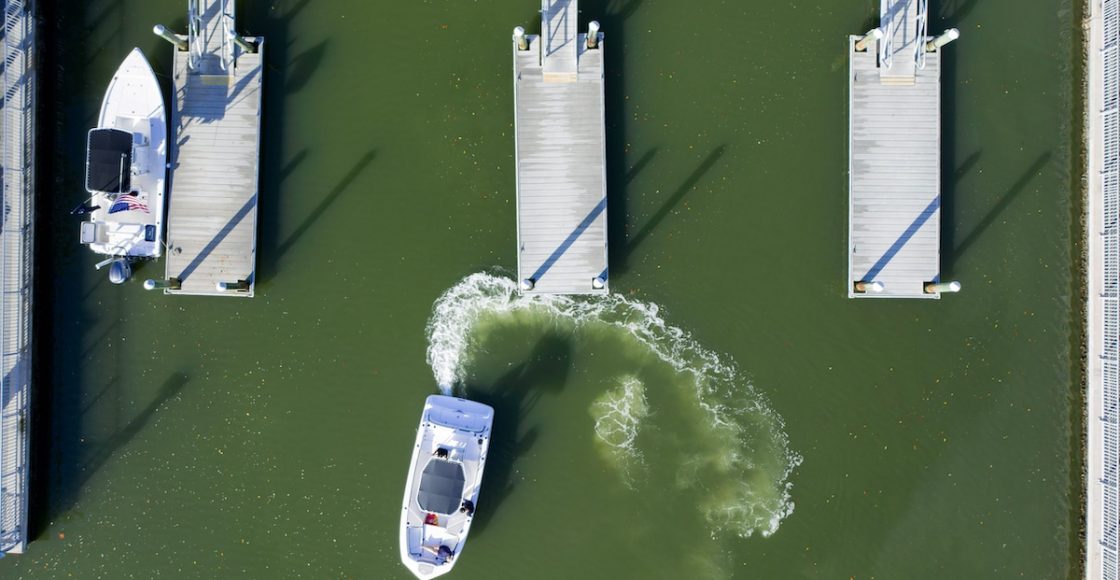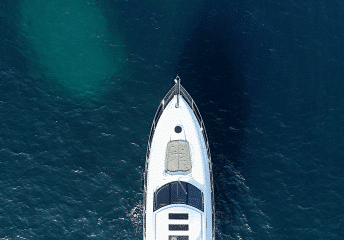Spring Commissioning Checklist: Getting Your Boat Ready for the Season
Last Updated on January 20, 2022 by Boatsetter Team
The ice is out, the weather is warming and the docks are back in place. Another season of boating is just around the calendar, which means it’s time to start getting your boat ready ready for spring. Before launching and starting a winterized boat engine, an experienced captain and boat owner follows a simple spring commissioning checklist. That way, problems identified and solved now won’t impact your coming season.

De-Wintering Your Boat’s Engine, Plumbing, & Electrical Systems
If your boat and engines were properly prepared for the off-season layup (winterization), those systems should be good to go for another year on the water. Otherwise, you’ll need to play catch-up. If you live in a climate where the boat never has an off-season, check with a dealer or your owner’s manual and complete an annual service if the engine is due.
- Change the engine oil and filter. (Next year do this in the fall before the boat is put up for the off-season—acids in dirty oil are bad for internal engine parts.)
- Change the gear lube in an outboard or sterndrive lower unit.
- Change the water pump impeller every two seasons.
- Remove the propeller from an outboard or sterndrive and inspect the propshaft seal area (where the shaft enters the gearcase) for fishing line and remove it. Use a small screw driver or a sharp pick. The fishing line may be coated in grease and hard to see. Line around the shaft can eat through the propshaft seal and allow water to enter the gearcase, which will lead to expensive damage. If you see a drip of oil on the gearcase skeg, or on the ground below the drive, the seal may be leaking. Have it checked by a pro technician.
- Apply marine grease to the propshaft before reinstalling the prop.
- Follow any other off-season service instructions in the engine owners manual, including lubrication of moving parts and checking the fluid levels in the power trim pump and in a closed cooling system if so equipped.
Don’t forget to give you boat a good cleaning before you launch – learn more in How to Clean a Boat. Once you’re ready to hit the water, be sure to check out 7 Ways to Spring into Boating.
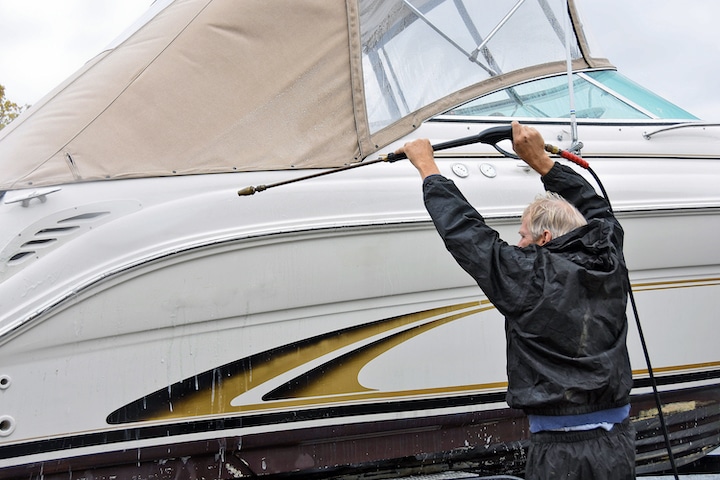
5 Tips for a Successful Spring Startup for Your Boat
In addition to de-winterizing your boat’s onboard systems, there’s a few other items to add to your boat’s spring checklist.
1. Uncover Your Boat Carefully
If the boat was stored under a cover or shrink wrap for the off-season, keep and eye out for critters that may have set up camp in your boat. Inspect the boat carefully for insect nests under the helm or seats and in storage compartments. An eruption of wasps will disrupt your day on the water.
2. Address Any Potential Fuel Issues
A boat with a built-in fuel tank should be stored with the tank filled with fresh gasoline that has been treated with a fuel stabilizer product. If that’s the case, you should be able to start the season with that treated fuel.
- Modern gas begins to “break down” in just a few weeks if it’s not stabilized.
- Storing the boat with less than a full tank can allow condensation to form in the tank, and now that water could be at the bottom of the tank, ready to foul your engine.
- If the fuel was not stored properly consider having the old fuel pumped out of the tank – some marine dealers will handle this task. Then start with fresh fuel, avoiding fuel blended with ethanol if that’s possible.
- It’s good practice to add fuel stabilizer to every tank of gas unless you know that fuel will be consumed in a few weeks.
If the boat is equipped with a remote fuel filter, the filter element should be changed before the new season (if it was not changed in the fall). Keep a spare filter on the boat for the day you get a tank of gas contaminated with water, which will eventually clog the filter. There are usually smaller filters on the engine (see owners manual) which should also be changed annually.
If your boat has a two-stroke outboard with oil injection, top off the oil reservoir with the correct oil, and keep a spare bottle of oil on board.
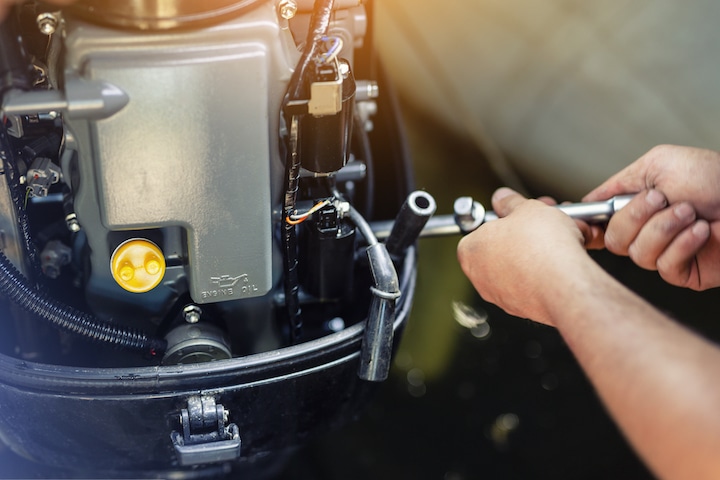
3. Check the Battery
Modern boats are pretty reliable, but according to marine techs the two most common sources of trouble are related to bad fuel and the batteries.
Reinstallation of boat batteries
During the off-season, it’s best to remove the batteries from the boat. Then, store them connected to a maintenance-type battery charger. If that was the case you can reinstall the batteries—but first give them a quick inspection.
- Check the date of purchase on the top of the battery. A marine battery has a typical life span of five to seven years, if it has been properly maintained. If your batteries are more than a few years old, a marine dealer or auto parts dealer can give the battery a load test to gauge its condition.
- If you question the condition or age of the battery, better to replace it now than to have its life end in the middle of the season, in the middle of the lake.
- When installing batteries, make sure they are secured with a good battery box or hold-down frame, which will keep the battery secure and also improve its life by protecting it from vibration or pounding in rough water.
- Check that both ends of each battery cable are tight and free from corrosion.
- Replace battery post wing nuts with self-locking (Nyloc) nuts that won’t come loose.
4. Check Everything, Then Check it Again
First, install the drain plug!
- If possible, put the boat in the water but keep it on its trailer or secured at the dock, start the engines and let them fully warm up.
- Inspect the engine bay for water, fuel or exhaust leaks, and make sure the water pump is pumping.
- Inspect the steering for smooth action and for any leaks in a hydraulic or power steering system. Also check the control cables for smooth action and proper shifting – cables sometimes need to be adjusted and lubricated. A binding control cable could cause an accident on the water.
- Go around the boat and give every system and accessory a test. Do all the lights work? The horn honks? Do the VHF radio and audio system work? Are all navigation and fishing electronics functioning, and have those units been updated with any new software recommended by the manufacturer? Try the wipers, the fresh water and wash down systems, live well and water ballast systems, the head, etc.
- Is all safety gear in place? You don’t want to get hailed for an inspection by the water police and find your flairs are out of date, for example, or your paddle is missing. Do you have all required registration and insurance documentation on board? One way to make sure you are compliant is to request a pre-season boat inspection by your local U.S. Coast Guard Auxiliary or similar organization.
- Are all tools and spares on board? There should be a spare propeller and required hardware, and the tools to change the prop. Maybe you borrowed a tool from the boat over the off-season and forgot to put it back.
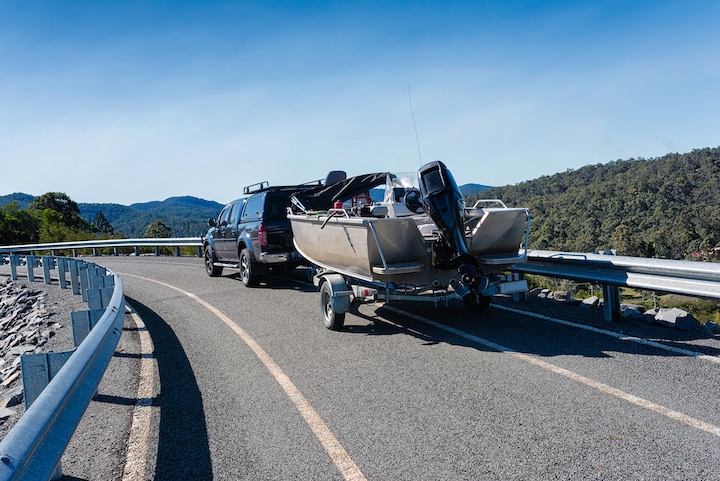
5. Follow an Annual Boat Trailer Maintenance Checklist
If you keep the boat on a trailer, follow this inspection checklist:
- Check the air pressure in the tires, including the spare. Towing at speed with low pressure leads to blow-outs. This leaves many boat owners by the side of the road early in the season. If you don’t have a trailer spare, get one and the tools and jack required to change a flat tire.
- Most boat trailers are equipped with a greasable wheel bearing protector (such as the Bearing Buddy brand). Follow manufacturers instructions and add grease as required. It’s a good idea to have the wheel bearings inspected before the season.
- Check the level and condition of brake fluid on a trailer equipped with brakes.
- Check all of the lights.
Learn How to List Your Boat Today on Boatsetter.

Charles Plueddeman is a self-employed writer and photographer based in Wisconsin. A staff editor and contributor to Boating Magazine since 1986, he is the author of its “Off My Dock” column. In the marine realm he specializes in engine technology and trailerable boats. His editorial work has appeared in many national publications, including Popular Mechanics, Men’s Journal, Playboy, Popular Science, Cycle World, and Harley-Davidson Enthuisast.
